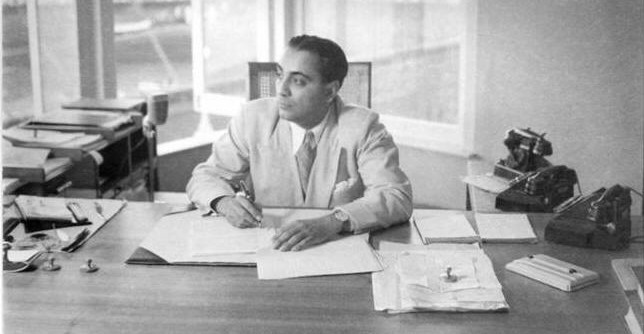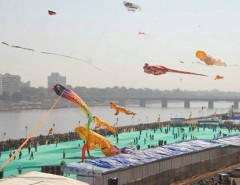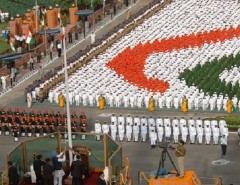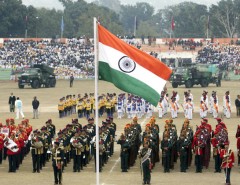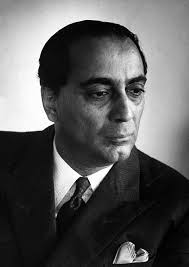 Homi Jehangir Bhabha (30 October 1909 – 24 January 1966) was an Indian nuclear physicist, founding director, and professor of physics at the Tata Institute of Fundamental Research. Colloquially known as “father of the Indian nuclear programme”, Bhabha was the founding director of two well-known research institutions, namely the Tata Institute of Fundamental Research (TIFR) and the Trombay Atomic Energy Establishment (now named after him); both sites were the cornerstone of Indian development of nuclear weapons which Bhabha also supervised as its director.
Homi Jehangir Bhabha (30 October 1909 – 24 January 1966) was an Indian nuclear physicist, founding director, and professor of physics at the Tata Institute of Fundamental Research. Colloquially known as “father of the Indian nuclear programme”, Bhabha was the founding director of two well-known research institutions, namely the Tata Institute of Fundamental Research (TIFR) and the Trombay Atomic Energy Establishment (now named after him); both sites were the cornerstone of Indian development of nuclear weapons which Bhabha also supervised as its director.
Early life
Homi Jehangir Bhabha was born into a wealthy and prominent industrial Parsi family, through which he was related to Dinshaw Maneckji Petit, and Dorabji Tata. He was born on 30 October 1909, in an illustrious family with a long tradition of learning and service to the country. His father was Jehangir Hormusji Bhabha, a well known lawyer and his mother was Meheren. He received his early education at Bombay’s Cathedral and John Connon School and entered Elphinstone College at age 15 after passing his Senior Cambridge Examination with Honors. His father’s name, Jehangir, is from Persian (جهانگیر), meaning conqueror of the world.
He then attended the Royal Institute of Science until 1927 before joining Caius College of Cambridge University. This was due to the insistence of his father and his uncle Dorab Tata, who planned for Bhabha to obtain a degree in Mechanical engineering from Cambridge and then return to India, where he would join the Tata Steel Mills in Jamshedpur as a metallurgist.
At the University of Cambridge
Bhabha’s father understood his son’s predicament, and he agreed to finance his studies in mathematics provided that he obtain first class on his Mechanical Sciences Tripos exam. Bhabha took the Tripos exam in June 1930 and passed with first class. Afterwards, he excelled in his mathematical studies under Paul Dirac to complete the Mathematics Tripos. Meanwhile, he worked at the Cavendish Laboratory while working towards his doctorate in theoretical physics. At the time, the laboratory was the center of a number of scientific breakthroughs. James Chadwick had discovered the neutron, John Cockcroft and Ernest Walton transmuted lithium with high-energy protons, and Patrick Blackett and Giuseppe Occhialini used cloud chambers to demonstrate the production of electron pairs and showers by gamma radiation.
During the 1931–1932 academic year, Bhabha was awarded the Salomons Studentship in Engineering. In 1932, he obtained first class on his Mathematical Tripos and was awarded the Rouse Ball traveling studentship in mathematics. During this time, the nuclear physics was attracting the greatest minds and it was one of the most significantly emerging fields as compared to theoretical physics, the opposition towards theoretical physics attacked the fields as it was lenient towards theories rather than proving the natural phenomenon through experiments. Conducting experiments on particles which also released enormous amount of radiation, was lifelong passion of Bhabha, and his leading edge research and experiments brought great laurels to Indian physicists who particularly switched their fields to nuclear physics, one of the most notable being Piara Singh Gill.
Research in Nuclear physics
In January 1933, Bhabha received his doctorate in nuclear physics after publishing his first scientific paper, “The Absorption of Cosmic radiation”. In the publication, Bhabha offered an explanation of the absorption features and electron shower production in cosmic rays. The paper helped him win the Isaac Newton Studentship in 1934, which he held for the next three years. The following year, he completed his doctoral studies in theoretical physics under Ralph H. Fowler. During his studentship, he split his time working at Cambridge and with Niels Bohr in Copenhagen. In 1935, Bhabha published a paper in the Proceedings of the Royal Society, Series A, in which performed the first calculation to determine the cross section of electron-positron scattering. Electron-positron scattering was later named Bhabha scattering, in honor of his contributions in the field.
In 1936, the two published a paper, “The Passage of Fast Electrons and the Theory of Cosmic Showers” in the Proceedings of the Royal Society, Series A, in which they used their theory to describe how primary cosmic rays from outer space interact with the upper atmosphere to produce particles observed at the ground level. Bhabha and Heitler then made numerical estimates of the number of electrons in the cascade process at different altitudes for different electron initiation energies. The calculations agreed with the experimental observations of cosmic ray showers made by Bruno Rossi and Pierre Victor Auger a few years before. Bhabha later concluded that observations of the properties of such particles would lead to the straightforward experimental verification of Albert Einstein’s theory of relativity. In 1937, Bhabha was awarded the Senior Studentship of the 1851 exhibition, which helped him continue his work at Cambridge until the outbreak of World War II in 1939.
Return to India
In September 1939, Bhabha was in India for a brief holiday when World War II started, and he decided not to return to England for the time being. He accepted an offer to serve as the Reader in the Physics Department of the Indian Institute of Science, then headed by renowned physicist C. V. Raman. He received a special research grant from the Sir Dorab Tata Trust, which he used to establish the Cosmic Ray Research Unit at the Institute. Bhabha selected a few students, including Harish-Chandra, to work with him. Later, on 20 March 1941, he was elected a Fellow of the Royal Society . With the help of J. R. D. Tata, he played an instrumental role in the establishment of the Tata Institute of Fundamental Research in Bombay.
Career
Starting his nuclear physics career in Great Britain, Bhabha had returned to India for his annual vacation before the start of World War II in September 1939. War prompted him to remain in India and accepted a post of reader in physics at the Indian Institute of Science in Bengaluru, headed by Nobel laureate C.V. Raman. During this time, Bhabha played a key role in convincing the Congress Party’s senior leaders, most notably Jawaharlal Nehru who later served as India’s first Prime Minister, to start the ambitious nuclear programme. As part of this vision, Bhabha established the Cosmic Ray Research Unit at the Institute, began to work on the theory of point particles movement, while independently conducting research on nuclear weapons in 1944. In 1945, he established the Tata Institute of Fundamental Research in Bombay, and the Atomic Energy Commission in 1948, serving as its first chairman. In 1948, Nehru led the appointment of Bhabha as the director of the nuclear program and tasked Bhabha to develop the nuclear weapons soon after. In the 1950s, Bhabha represented India in IAEA conferences, and served as President of the United Nations Conference on the Peaceful Uses of Atomic Energy in Geneva, Switzerland in 1955. During this time, he intensified his lobbying for the development of nuclear weapons. Soon after the Sino-Indo war, Bhabha aggressively and publicly began to call for the nuclear weapons.
Bhabha gained international prominence after deriving a correct expression for the probability of scattering positrons by electrons, a process now known as Bhabha scattering. His major contribution included his work on Compton scattering, R-process, and furthermore the advancement of nuclear physics. He was awarded Padma Bhushan by Government of India in 1954. He later served as the member of the Indian Cabinet’s Scientific Advisory Committee and provided the pivotal role to Vikram Sarabhai to set up the Indian National Committee for Space Research. In January 1966, Bhabha died in a plane crash near Mont Blanc, while heading to Vienna, Austria to attend a meeting of the International Atomic Energy Agency’s Scientific Advisory Committee.
Legacy
After his death, the Atomic Energy Establishment at Bombay was renamed as the Bhabha Atomic Research Centre in his honour.
In addition to being an able scientist and administrator, Bhabha was also a painter and a classical music and opera enthusiast, besides being an amateur botanist.[citation needed]He is one of the most prominent scientists that India has ever had. Bhabha also encouraged research in electronics, space science, radio astronomy and microbiology.[citation needed] The famed radio telescope at Ooty, India was his initiative, and it became a reality in 1970. The Homi Bhabha Fellowship Council has been giving the Homi Bhabha Fellowships since 1967 Other noted institutions in his name are the Homi Bhabha National Institute, an Indian deemed university and the Homi Bhabha Centre for Science Education, Mumbai, India.
Trivia
On 13 March 2014, The Times of India reported that The National Centre for the Performing Arts (NCPA) had issued a public notice inviting developers and investors interested in purchasing Mehrangir, the sprawling colonial bungalow at Malabar Hill where Bhabha, spent most of his life. The bungalow has a builtup area of 13,953 sq feet and a plot measuring 17,150 sq feet.
After Bhabha died in 1966, his brother Jamshed became the custodian of the Bhabha estate. Being an avid patron of arts and culture, Jamshed Bhabha, who died in 2007, aged 93, had willed the property along with paintings, jewellery, artefacts and furniture to the NCPA, which he had established. Located at a stone’s throw from Hanging Gardens, the property is estimated to be valued at over Rs 257 crore (as of March 2014) and was sold to Godrej family for Rs 372 crore by the NCPA on 18 June 2014.
The employees and scientists working for Department of Atomic Energy and Tata Institute of Fundamental Research, which Bhabha founded, have protested against the sale of the bungalow to private developers as they believe that the bungalow should be preserved as a memorial. However NCPA chairman K N Suntook said that such sentiments “were misplaced”. He said that Homi Bhabha, the architect of India’s nuclear power programme, was only a part owner of the property and after his demise, the property “devolved solely upon his brother Jamshed, who bequeathed it absolutely to the NCPA by his will, which has since been probated”.
Suntook said he was sad that eminent scientists were supporting this movement and that BARC has lot of funds and they could have used that to bid for the bungalow. While there were eight bidders originally, three turned up for the auction. Suntook added that Homi Bhabha was a great lover of culture himself and both brothers would have been disappointed with the opposition to the auction.
The present owner of Mehrangir (Smita-Crishna Godrej, Godrej family) who had purchased Mehrangir, Homi Bhabha’s home in Mumbai, had it demolished it during the first week of June 2016. As per eminent scientists opposed to auction, the central or state governments could have saved Mehrangir by compensating the NCPA by a reasonable amount. However this did not happen, the bungalow was auctioned off in 2014 and demolished in June 2016, bringing much dismay to those who wanted it declared a heritage structure.
- Born – 30 October 1909
- Died – 24 January 1966
- Nationality – India
- State – Gujarat

